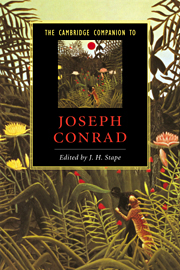11 - Conrad and Modernism
Published online by Cambridge University Press: 28 May 2006
Summary
If we take 'Modernism' to mean certain fundamental and more or less shared characteristics of those writers, thinkers, and artists of the period 1900-30, in Britain, Europe, America, and elsewhere, who are now (subjectively and from our own stance in history) seen as the most 'new' or responsive or influential of that time, it seems inevitable that Conrad should figure in that grouping.
In terms of dating there is little doubt about this. The period of his major creativity is from 'Heart of Darkness' (1899) to at least Under Western Eyes (1911) and possibly beyond, to Victory (1915) and The Shadow-Line (1917). During that period there also appeared Freud's Interpretation of Dreams (1900), Einstein's theory of relativity (1905), William James's Pragmatism (1907), and Jung's Psychology of the Unconscious (1912). In 1907, the year of The Secret Agent , Picasso‘s Les Demoiselles d‘Avignon revolutionized modern painting, and saw the birth of Cubism (hailed by Apollinaire in 1913). In 1908, Schönberg composed his first complex atonal pieces, and changed the course of modern music; Proust, in 1913, published the first volumes of A la recherche du temps perdu , which in its own way changed the tonality of modern fiction (and was at once read and admired by Conrad). In 1912, the year of Conrad‘s dream-like narrative of the double self, ‘The Secret Sharer’, Mann published Death in Venice , perhaps the most resonant, and certainly the most Nietzschean, of Modernism‘s characteristic studies of self-division. In 1914, Conrad‘s Chance came out at the same time as Gide‘s Les Caves du Vatican (an author whom Conrad knew and, with reservations, admired). Rilke‘s New Poems, in 1907-8, and his prose work, Make Laurids Brigge, in 1910, were milestones in the development of Symbolism and in the exploration of the growing alienation of the creative sensibility from the contemporary world.
- Type
- Chapter
- Information
- The Cambridge Companion to Joseph Conrad , pp. 203 - 222Publisher: Cambridge University PressPrint publication year: 1996
- 3
- Cited by



